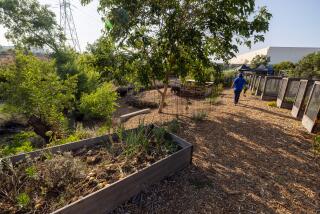A City Helps Its Image by Aiding Schools
- Share via
SANTA FE SPRINGS — This city of 15,500 has given four school districts more than $4.3 million over the past 10 years to paint, prune, spruce up and plant.
Cities almost never help finance school maintenance, but officials in Santa Fe Springs want schools to keep pace with their efforts to reshape the image of a city, once known for hazardous waste sites, oil refineries and warehouses.
The latest aid is $150,000 approved last month by the city Redevelopment Agency to fund most of a new kindergarten play area at Lakeview Elementary School.
“We’ve been doing a lot to try to improve the appearance of Santa Fe Springs over the last decade, and the appearance of the schools was part of the total appearance of the city,” City Manager Don Powell said.
During the last 20 years, the 9-square-mile city has developed abandoned oil fields into tax-producing business parks. It landscaped the median strips on city streets and designed appealing railway overpasses. The city spent more than $4 million to create Heritage Park, with artifacts that include Victorian gardens and an antique carriage barn. It spent about $3.5 million to make a museum of the dilapidated Clarke Estate, built just before the local oil boom in the 1920s.
The schools failed to make the same progress. Cuts in state funding have resulted in reductions in maintenance.
“We didn’t have the maintenance crews, staff or money,” said Supt. John Pulice of the Little Lake City School District. “The athletic fields, I am ashamed to say, were pocked with gopher holes.”
The city offered to convert the school yards at the district’s three Santa Fe Springs campuses to recreational parks. The schools would use them by day, the city by night and during the summer. The three-year, $3-million make over was completed in 1984.
“We’ve created some nice parks,” Powell said, but the aging school buildings also needed serious help.
In 1982, city maintenance crews took over the job of removing graffiti from schools. In 1984, the city set aside an annual stipend of $10,000 for each campus, Powell said. Little Lake got the money for maintenance projects on a matching, dollar-for-dollar basis. The South Whittier and Los Nietos districts have the same deal.
The city also spent $150,000 to stock emergency supplies at all area schools, including those supported by private funds. Each bin contains generators, blankets, dried foods, water containers, lights and medical supplies in case of an earthquake or other disaster.
The city has landscaped much of the grounds at Santa Fe High School, helped paint the buildings, and supplied fencing and lighting.
“It’s done to a large extent because the high school is right in the middle of our residential area,” Powell said.
Taxes from increases in property values paid for the improvements. During the last 10 years, the city’s property values have more than doubled to $2.5 million, finance director Don Nuttall said.
Almost all of that increase has taken place as a result of businesses moving into city redevelopment zones. This year, the city’s redevelopment agency expects to collect about $11.4 million in property taxes. About 90% of that will pay the agency bills; a good portion of the rest, about $335,000, will go to schools. That averages out to more than $72 for each school-age student living in Santa Fe Springs, according to 1990 Census figures.
“We think it’s a good use of money if we’re trying to keep a community up,” Nuttall said.
“It is very unusual for cities and school districts to have that kind of cooperation,” Supt. Pulice said. His elementary school district is the major beneficiary. Most of Little Lake’s 4,000 students live in the city.
School officials from elsewhere envy the help that Santa Fe Springs schools receive.
“Santa Fe Springs is flush” with money, said Deputy Supt. Ron Bennett of Long Beach Unified. “You have a city that has a good tax base and not proportionally a lot of citizens to support with it. I’m glad they’re able to (help). I wish other cities were able to, but the reality is they’re not going to be able to do so.”
“We have schools that haven’t been painted since they were first built 35 years ago,” said Margaret Scholl, director of maintenance for Los Angeles Unified. “Playgrounds that haven’t been repaved since the schools were constructed.”
Not so in Santa Fe Springs. “Our schools are all freshly painted and look great,” Pulice said.
Despite the sparkling buildings and grounds, Little Lake suffers from the same problems inside the classroom that afflict districts statewide. The school board recently approved dropping district music and art programs and elementary school counselors if the state adopts Gov. Pete Wilson’s proposed cuts in school funding. District reading teachers and specialists for teaching English as a second language would also be eliminated.
But cosmetically, at least, the district continues to shine. Thanks to the most recent city action, Lakeview kindergartners will have a new, landscaped mini-park to look forward to this fall, complete with athletic equipment, jungle gyms, climbing bars, a sandbox, a grass lawn, a concrete tricycle track and a wrought-iron fence.
“Every city can’t afford to do that,” Nuttall said. “I guess we’re lucky that we can.”
More to Read
Sign up for Essential California
The most important California stories and recommendations in your inbox every morning.
You may occasionally receive promotional content from the Los Angeles Times.











